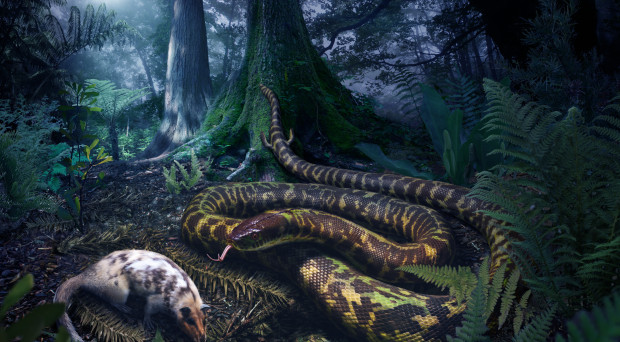
Snakes have long captured the human imagination. Their instantly recognizable slithering bodies, flickering tongues, and fearsome reputations have rendered them icons of fascination and fear throughout human history.
The intrigue surrounding snakes has also attracted attention from the scientific community. Herpetologists have long debated the origin and evolution of snakes. Several major questions have shaped this debate, including whether snakes originated on land or in the seas, and whether snakes originated on the Mesozoic supercontinent of Gondwana or Laurasia. Additionally, scientists have wondered how, when, and why snakes became so diverse (living snakes comprise over 3,000 species).
Historically, these questions have been difficult to answer, due in no small part to a lack of informative snake fossils. Fossils are essential for reconstructing the evolutionary history of organisms. They are our only means of catching a glimpse, however brief and incomplete, of how life actually evolved on Earth. Summarily inferring the history of life with only living species would be simply impossible: after all, how would we ever have postulated the existence of dinosaurs if we had only their closest living relatives – birds – to work with?
A host of significant fossil snakes have come to light over the last decade, which together reveal new insights into how and why modern snakes came to be.
Luckily, a host of significant fossil snakes have come to light over the last decade, which together reveal new insights into how and why modern snakes came to be. These include better-preserved, more complete specimens of previously known fossil snakes, as well as entirely new fossil taxa such as Kataria anisodonta and Sanajeh indicus.
Thanks to these recent paleontological advances, the stage was primed for addressing big questions about snake evolutionary history. We, along with our colleagues at Yale University, assembled the most comprehensive dataset to date combining genetic and anatomical data from living and fossil snakes. This dataset allowed us to evaluate the early evolutionary history of snakes using cutting edge computational techniques, in order to generate the first analytical reconstruction of the common ancestor of all snakes.
Our results strongly suggest that snakes originated on land, rather than in the seas, as the oldest snake fossils currently known – Coniophis, Najash, and Dinilysia – are all terrestrial.
As for whether snakes evolved on Gondwana or Laurasia, our results suggest an intriguing possibility: while the most recent common ancestor of living snakes likely originated in the southern hemisphere around 100 million years ago, the most recent common ancestor of all animals, living or extinct, that is more closely related to living snakes than to any other group may have inhabited Laurasia around 128 million years ago. (Laurasia is the Mesozoic supercontinent made up of the land masses that we call North America, Europe, and Asia today).

Based on the results of our study, we are developing a picture of how these ancestral snakes would have lived and behaved alongside the dinosaurs during the Cretaceous period.
They likely lived in warm, well-watered, well-vegetated environments – not unlike today’s forests, although the composition of plants and animals in these environments would have been entirely different from what we see today.
The ancestral snakes were also nocturnal in their habits, widely foraging for soft-bodied prey that were about the same size as their heads – for instance, small mammals such as Yanoconodon, as depicted in the painting by Julius Csotonyi accompanying our study. Unlike modern snakes such as the boa constrictor, the ancestral snake had yet to evolve the ability to manipulate prey items much larger than its head, and could not yet constrict its prey.
Snakes were around during the latter portion of the age of dinosaurs, which means that they, too, experienced the catastrophic bolide impact that marked the end of the Mesozoic era, resulting in the complete extinction of non-avian dinosaurs.
However, our results suggest that snakes actually did quite well for themselves in the wake of this extinction event: henophidian snakes – which comprise the lion’s share of snake diversity today – seem to undergo a major and extensive radiation following the extinction event.
Most likely, the ancestors of modern henophidian snakes were able to take advantage of the relatively empty landscape left behind by the dinosaurs.
Most likely, the ancestors of modern henophidian snakes were able to take advantage of the relatively empty landscape left behind by the dinosaurs. They had free reign to fill up whatever empty niches they could, just as mammals did, after the demise of the formerly ecologically dominant dinosaurs.
We now have a much clearer picture of the early evolutionary history of snakes, both in terms of how and when they became so diverse, and how they behaved and flourished during the Mesozoic. Of course, as with any field of science, there’s always more to know. As paleontologists, we always hope for future exciting fossil discoveries that will shed even more light on the evolution of these fascinating organisms.
4 Comments